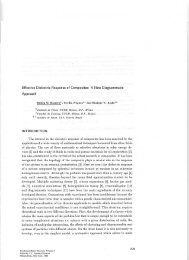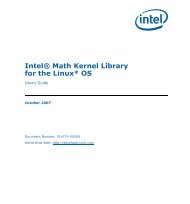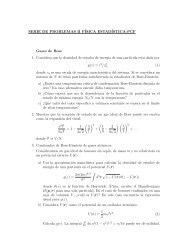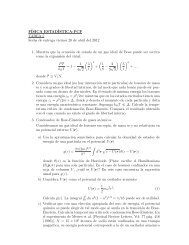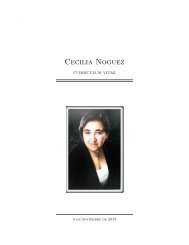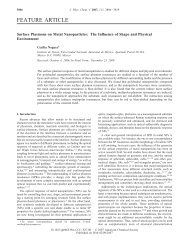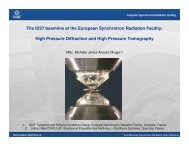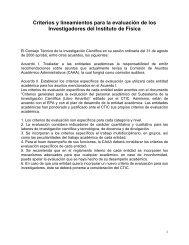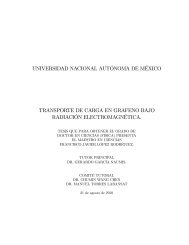Intrinsic Chirality in Bare Gold Nanoclusters: The Au34# Case - UNAM
Intrinsic Chirality in Bare Gold Nanoclusters: The Au34# Case - UNAM
Intrinsic Chirality in Bare Gold Nanoclusters: The Au34# Case - UNAM
Create successful ePaper yourself
Turn your PDF publications into a flip-book with our unique Google optimized e-Paper software.
<strong>Intr<strong>in</strong>sic</strong> <strong>Chirality</strong> <strong>in</strong> <strong>Bare</strong> <strong>Gold</strong> <strong>Nanoclusters</strong> J. Phys. Chem. C, Vol. 112, No. 45, 2008 17535<br />
Figure 2. Calculated molecular scatter<strong>in</strong>g function for the C 1 (blue),<br />
C 3 (black), and C 3v (red) isomers of the Au 34- cluster.<br />
Figure 1. Optimized geometries for the Au 34- clusters obta<strong>in</strong>ed at<br />
the DFT-GGA-PBE level of theory.<br />
TABLE 1: Table 1<br />
isomer Au 34<br />
-<br />
HCM isomer Au 34 isomer Au 34<br />
+<br />
1 0.000 0.115 1 0.000 1 0.000<br />
2 0.031 0.121 4 0.134 2 0.170<br />
3 0.080 0.004 5 0.161 3 0.184<br />
4 0.099 0.007 3 0.181 4 0.187<br />
5 0.144 0.102 2 0.182 6 0.280<br />
6 0.152 0.006 6 0.222 7 0.415<br />
7 0.355 0.089 8 0.600 5 0.469<br />
8 0.491 0.018 7 0.607 8 0.494<br />
9 0.638 0.006 9 0.801 9 0.538<br />
carbon nanotubes 34 and chiral molecules and fullerenes 35 like<br />
C 76 and C 84 , obta<strong>in</strong><strong>in</strong>g good agreement with previous TDDFT<br />
calculations and experimental results. 34,35<br />
Results and Discussion<br />
<strong>The</strong> structural optimization of the Au Z 34 (Z )-1, 0, 1)<br />
clusters, us<strong>in</strong>g the DFT-GGA methodology described above,<br />
allows us to obta<strong>in</strong> the isomers with the lowest total energy,<br />
which would correspond to the most stable cluster structures.<br />
<strong>The</strong> n<strong>in</strong>e isomers with the lowest energy we obta<strong>in</strong>ed for the<br />
Au - 34 cluster are displayed <strong>in</strong> Figure 1, 36 whereas the correspond<strong>in</strong>g<br />
relative total energies are presented <strong>in</strong> Table 1. <strong>The</strong><br />
lowest energy isomer we found for the Au - 34 cluster is that<br />
one with C 1 (chiral) po<strong>in</strong>t symmetry. This structure was first<br />
obta<strong>in</strong>ed by Gu et al., 15 us<strong>in</strong>g a bas<strong>in</strong>-hopp<strong>in</strong>g global optimization<br />
technique comb<strong>in</strong>ed with the DFT-GGA method. An<br />
<strong>in</strong>terest<strong>in</strong>g result from the present study is that the same C 1<br />
isomer is also the most stable configuration for the neutral Au 34<br />
and cationic Au + 34 clusters. This is <strong>in</strong> contrast with the trend<br />
we obta<strong>in</strong>ed <strong>in</strong> the study of the structural properties of the Au Z 32 ,<br />
(Z )-1, 0, 1), clusters, where the most stable isomer for the<br />
neutral Au 32 cluster is the I h cagelike isomer, whereas for the<br />
anionic and cationic Au 32 clusters, a C 1 structure is the most<br />
stable one. 13 Table 1 also shows the relative total energies of<br />
the neutral Au 34 and cationic Au + 34 cluster isomers tak<strong>in</strong>g as<br />
reference, like <strong>in</strong> the case of the anionic case, the total energy<br />
of the correspond<strong>in</strong>g most stable C 1 isomer.<br />
For the anionic Au - 34 cluster, an isomer with C 3 (chiral) po<strong>in</strong>t<br />
symmetry, isomer 2, was found nearly degenerate <strong>in</strong> energy<br />
(∆E ) 0.031 eV) with the C 1 isomer. Isomer 2 is also the second<br />
one <strong>in</strong> the energy order<strong>in</strong>g for the cationic Au + 32 cluster, but<br />
the difference <strong>in</strong> energy with the C 1 isomer is higher (∆E )<br />
0.170 eV); whereas for the neutral case, it is the fifth isomer,<br />
0.181 eV higher <strong>in</strong> energy. <strong>The</strong> C 3 isomer was first reported <strong>in</strong><br />
ref 14 as the most stable isomer for the Au - 34 cluster after a<br />
limited structural optimization us<strong>in</strong>g DFT; whereas <strong>in</strong> ref 15 it<br />
was found as the third isomer <strong>in</strong> the energy order<strong>in</strong>g.<br />
<strong>The</strong> relative total energies shown <strong>in</strong> Table 1 <strong>in</strong>dicate that the<br />
energy order<strong>in</strong>g of the n<strong>in</strong>e lowest-ly<strong>in</strong>g isomers is the same<br />
for the anionic and cationic 34 atom gold clusters, but <strong>in</strong> the<br />
case of the neutral cluster, these isomers are distributed <strong>in</strong> a<br />
different way. This result, also found <strong>in</strong> the structural optimization<br />
of the Au Z 32 ,(Z )-1, 0, 1), clusters, 13 confirms the trend<br />
that the addition or subtraction of a s<strong>in</strong>gle charge on a neutral<br />
gold cluster with as many as 34 atoms could be enough to<br />
modify the energy order<strong>in</strong>g of their isomers.<br />
<strong>The</strong> geometries of isomers 3-9 of the Au - 34 clusters displayed<br />
<strong>in</strong> Figure 1 correspond to low-symmetry and chiral structures.<br />
Isomers 3, 4, 6, and 9 only have a s<strong>in</strong>gle plane of symmetry (C s<br />
po<strong>in</strong>t symmetry) and isomers 5, 7, and 8 have no symmetry at all<br />
(C 1 po<strong>in</strong>t symmetry). <strong>The</strong> four isomers with C s po<strong>in</strong>t symmetry<br />
are achiral whereas the rema<strong>in</strong><strong>in</strong>g 3 isomers with C 1 po<strong>in</strong>t<br />
symmetry are chiral. One way to quantify, from a geometrical po<strong>in</strong>t<br />
of view, the <strong>in</strong>dex of chirality of these isomers is through the<br />
Hausdorff chirality measure (HCM), which was <strong>in</strong>troduced <strong>in</strong> refs<br />
17-19. <strong>The</strong> calculated HCM values for the 9 isomers of the Au<br />
- 34<br />
cluster are displayed <strong>in</strong> Table 1. As expected, the HCM values for<br />
the four achiral isomers are almost equal to zero, whereas the C 3<br />
isomer has the largest <strong>in</strong>dex of chirality. <strong>The</strong> energetic predom<strong>in</strong>ance<br />
of chiral and low-symmetry structures for the lowest-ly<strong>in</strong>g<br />
isomers of gold clusters around the present size is another emerg<strong>in</strong>g<br />
trend that from this and other related calculations can now be firmly<br />
established.<br />
<strong>The</strong> results discussed above on the energetic order<strong>in</strong>g of the<br />
most stable isomers of the Au - 34 cluster are <strong>in</strong> good agreement<br />
with those obta<strong>in</strong>ed by Gu et al. 15 In particular, we confirmed<br />
that the C 1 isomer is the lowest-energy one, and, therefore, the<br />
best candidate for the global m<strong>in</strong>imum, as it was suggested <strong>in</strong><br />
ref 15. On the other hand, this isomer was not considered for<br />
the <strong>in</strong>terpretation of the TIED and PES spectra <strong>in</strong> ref 14, but it<br />
was suggested that the C 3 isomer fits better both sets of<br />
experimental data. 14 Because the C 1 isomer was found to be




